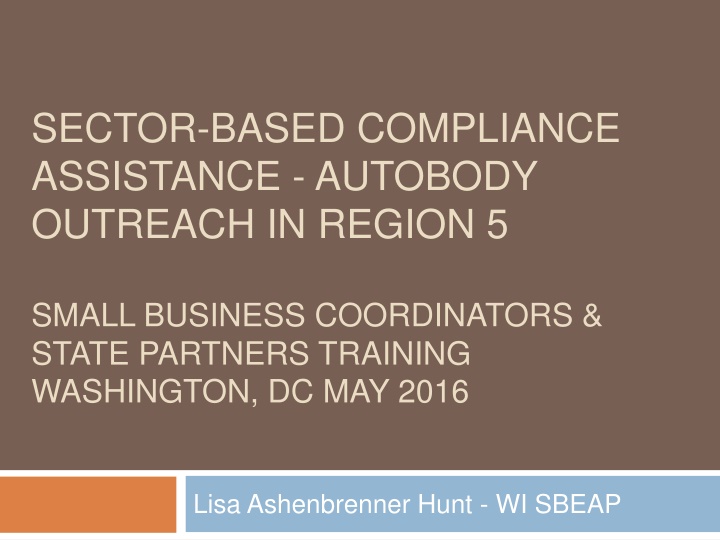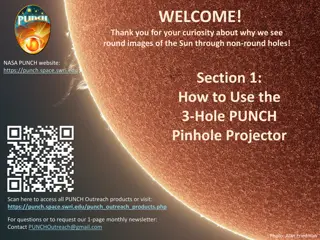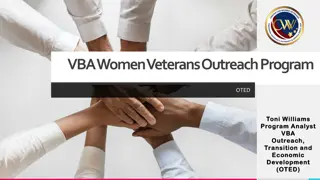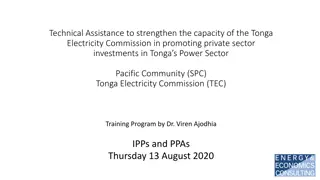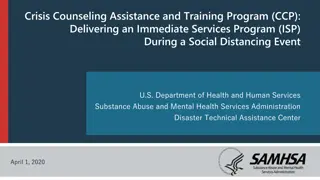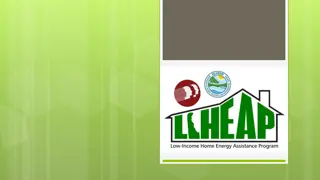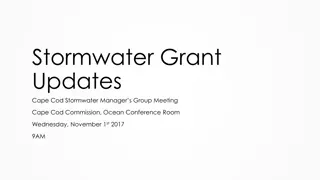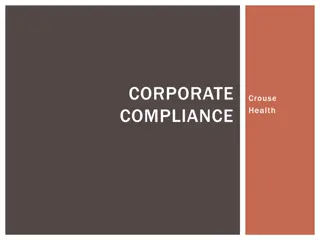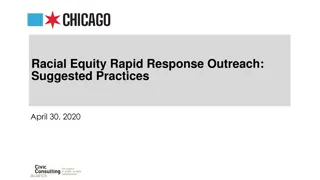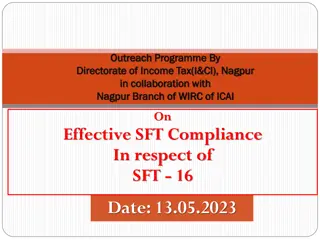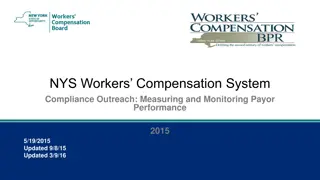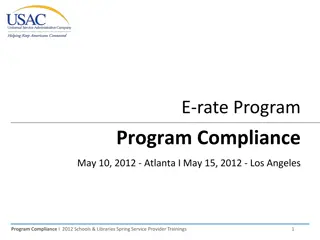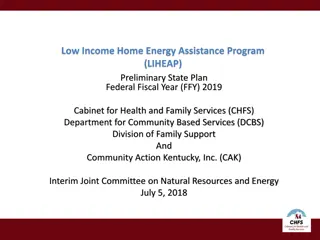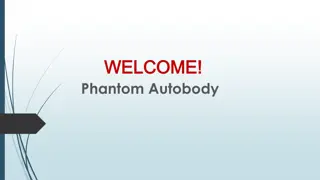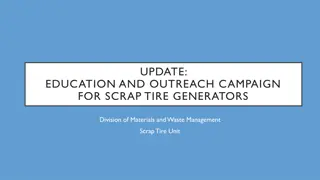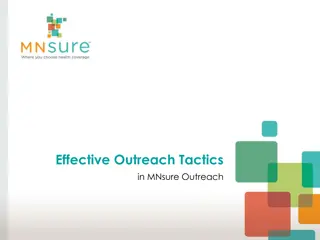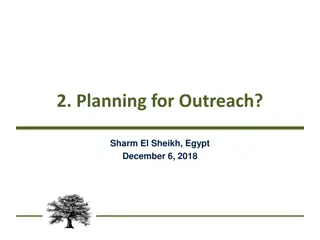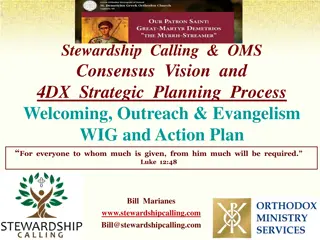Sector-Based Compliance Assistance & Autobody Outreach Program
Environmental Results Program (ERP) utilizes statistical methods to assess compliance gaps in sectors with small sources. The program includes baseline visits, outreach, training, and inspections to measure changes. The State ERP Consortium and Area Source NESHAP Compliance are crucial components. Region 5 SBEAPs provide a solution to reach autobody shops and involve EPA in enforcement through innovative grants.
Download Presentation

Please find below an Image/Link to download the presentation.
The content on the website is provided AS IS for your information and personal use only. It may not be sold, licensed, or shared on other websites without obtaining consent from the author.If you encounter any issues during the download, it is possible that the publisher has removed the file from their server.
You are allowed to download the files provided on this website for personal or commercial use, subject to the condition that they are used lawfully. All files are the property of their respective owners.
The content on the website is provided AS IS for your information and personal use only. It may not be sold, licensed, or shared on other websites without obtaining consent from the author.
E N D
Presentation Transcript
SECTOR-BASED COMPLIANCE ASSISTANCE - AUTOBODY OUTREACH IN REGION 5 SMALL BUSINESS COORDINATORS & STATE PARTNERS TRAINING WASHINGTON, DC MAY 2016 Lisa Ashenbrenner Hunt - WI SBEAP
Overview Environmental Results Programs Concepts and Applications Area Source Rules Challenges and Opportunities Value of Partnerships Sector-specific Outreach and Multimedia Assistance
Environmental Results Program (ERP) Use sampling and statistical methods to assess compliance and education gaps in sectors with many small sources Baseline visits to measure initial compliance Conduct outreach and facility training Collect self-assessments with certification Follow-up inspections to measure changes Statistical analysis to measure status, changes in compliance 100 80 sample size 60 40 20 0 1 2000 4000 6000 8000 10000 12000 14000 16000 18000 20000 population size * margin of error +/-10% and confidence level 95%
Area Source NESHAP Compliance Most states don t inspect minor air pollution sources and didn t take delegation of the Area Source NESHAPs EPA has few resources to inspect Area Sources for NESHAP compliance How do you increase the number of emissions sources you inspect without more staff?
Region 5 SBEAPs Solution to 6H Question: How to reach 12,000 autobody shops in Region 5 Relying on SBEAPs and compliance assistance tools to reach them How do we also get Region 5 EPA involved since they have primary enforcement role? Answer: Use EPA s state innovation grant for ERP on autobody refinishing sector in Region 5 Combined population of shops in six states Enlisted EPA Region 5 air enforcement as partner Focused on urban areas and the new surface coating area source NESHAP (40 CFR, Part 63, subpart HHHHHH = 6H)
State Outreach State Events Articles - Publication Online Training Materials Factsheets/ Postcards 17 (825) Clean Air Clips: Feb and Oct, 2011 Region 5 ERP Webpage (8223) 3 Factsheets IL 9 (334) CTAP Hot Topic: Jan 2010 Collision Repair Assistance website Region 5 ERP Webpage (8223) 1 Factsheet and Compliance Manual IN Checklist Tutorial (328) & Rule Overview Video (381) Webpage & Region 5 ERP Webpage (8223) 32 local, 1 webinar (70) DNRE Web Article 4 Factsheets MI AASP-MN: 10/09, 1/10, 3/10, 7/10, 11/10 (2) MN SBEAP Enterprise, Fall 2010 5 (88) Webpage & Region 5 ERP Webpage (8223) 4 Factsheets Initial & Reminder Postcards MN 31 (1030) OCAPP Newsletter: Winter 08, Summer 09, Fall10 Webpage & Region 5 ERP Webpage (8223) 2 Email Reminders 1 Reminder Postcard OH The Autobody Journal, June/July 2008 WACTAL Newsletter, 2010 13 (465) Region 5 ERP Webpage (8223 total Pageviews; 1972 files 3 mo in 2010 limited document data) 3 Factsheets 1 Reminder Postcard WI
Partnerships WI - Invited to local trade association meetings, attended annual/biannual meetings with presentation or booth OH - Workshops through paint suppliers, Jeff Gordon video/info from PPG, Sherwin-Williams, DuPont helped legitimize rule as industry best practices MI Partnership with Automotive Service Association of MI and vendors MN Partnered with Association of Automotive Service Providers MN (AASP-MN), published articles in their newsletter (trusted source) IL - Partnered with the SBDCs to put on workshops throughout the state, some workshops organized by paint suppliers IN - Worked with vocational schools, auto body associations, suppliers; partnered with EPA on presentations, participated in the IABA convention Potential inspections from EPA increased shop owner interest Combined messaging: mailings from the state, information from associations and vendors, and word of mouth efforts helped strengthen message
Outreach Questions Source for regulatory information? Best way to get information? Mailing/letter 65% Emails 50% Workshops 30% Video-based 20% Web-based 17% On-site Visits 17% Coating suppliers 85% Other suppliers 34% Trade association 30% Other shops 20% SBEAPs 7%
Initial Awareness Know about the rule before visit? Yes = 64.3% Know coatings contain HAPs? Yes = 21.9% Aware of petition for exemption option? Yes = 18.54% No, but want more info = 31.8% After learning about petition for exemption option, will you petition or comply? Not sure = 33.5% Explore alternates, decide later = 28.4% Continue using HAPs, comply = 27.7% Stop using and petition = 10.3%
Self-Certification Checklist Question(s) in Checklist EBPIs Practices Associated with subpart 6H % using HVLP or equivalent high transfer efficiency technology % with high transfer efficiency painting training in place % with different components of training % using hands-on or classroom-only training % with documentation of training % at which all spray-applied coatings used in enclosed booth or prep station I6 B2a B2b B2b B2c C3, I1, I3 % of booths/stations fitted with particle filters % of booths/stations fitted with filter/system achieving 98% capture C4b, I2, I4 C4c&d % where spray gun cleaning is done with enclosed or non-atomizing washers % maintaining MSDS or formulation records for all solvents/coatings use % maintaining records of the amount/content of coatings containing HAPs C5, I7 C9 C10 % NOT using paint strippers containing Methylene Chloride % keeping records to document annual MeCl usage Average and range of MeCL used % of MeCL users with written MeCl minimization plan C6, I8 C7 C7b C8 % maintaining records of the amount of coatings containing VOC and HAP A6
Beyond 6H Question(s) in Checklist EBPIs Other Practices AIR PRACTICES Paint hours per year Average quantity and range of coatings used % using dustless vacuum or overhead capture equipment % meeting applicable state requirements AIR RECORD KEEPING: Average use of high VOC and low VOC coatings and solvents per year HAZARDOUS WASTE Average and range of maximum amount of RCRA waste the facility generates in a month A7 A6 F1 Varied A6 D3 Numbers of facilities in generator classes (CESQG or VSQG, SQG, LQG or not) INDUSTRIAL WASTERWATER INDICATORS % of facilities not discharging IWW to surface water % of facilities not discharging IWW to a storm, sanitary or combined sewer system POLLUTION PREVENTION-ENERGY EFFICIENCY INDICATORS % of facilities taking one or more actions to conserve energy over the past three years (distribution across menu of possible actions) % of facilities taking one or more actions to reduce pollution (VOC, PM and toxics) the past three years (distribution across menu of possible actions) D3 E2 E2 G1 F1
Pollution Prevention Actions to reduce toxics in the past 3 years Number Percent VOC/HAP Keep ALL solvent containers closed 113 92.60% Ask suppliers for non-HAP metal coatings 36 29.50% Use paintless dent repair techniques 93 76.20% Avoid methylene-chloride paint strippers 101 82.80% Automatic enclosed gun washer 74 60.70% Use water-based or low-VOC coatings 26 21.30% Use low-VOC solvents or thinners 38 31.10% Two-stage solvent use 38 31.10% Recycle solvents with on- or off-site distiller 31 25.40% First-in, first-out system to prevent spoilage 83 68% Computerized paint mixing to reduce mistakes 97 79.50% Use non-solvent based putty/fillers 28 23.00% Dust/PM Use a disposable paint cup system 67 54.90% Use a ventilated sander 28 23.00% Reusable aerosol or pump spray containers Use roll-on primer 52 13 42.60% 10.70%
Energy Efficiency Actions to reduce energy use in the past 3 years Number Percent Booths Energized only when necessary 112 91.80% Booth lights kept clean 107 87.70% Filters changed regularly for good airflow 111 91.00% Booth fan motors have variable speed drives 28 23.00% Booth uses heated air recirculation 68 55.70% Booth lighting on timers/motion sensors 26 21.30% Timers, motion sensors, smart thermostats 48 39.86% Shop Installed efficient fluorescent lights (<T-12) 72 59.00% Cleaned light fixture reflectors 76 62.30% Reduced lighting intensity where acceptable 41 33.60% Taken advantage of day-lighting 66 54.10% Completed an energy audit 19 15.60% Insulated building, windows, ducts, pipes 48 39.30% Regularly check/repair compressed air leaks 108 88.50% Use electric tools instead of compressed air 77 63.10%
EPA Follow-up Inspections Calling ahead (not SOP for EPA) seemed to improve attitude during inspection and ensured efficient trips - could verify that sources were open and affected by the rule Shops support regulation and want to comply Many shops not interested in exemption even if eligible Shops felt validated by actually getting visited by federal inspector
Before and After Compliance EBPIs
Questions? Lisa Ashenbrenner Hunt Environmental Assistance Coordinator Small Business Environmental Assistance Program Wisconsin Department of Natural Resources Lisa.AshenbrennerHunt@wisconsin.gov (608) 266-6887
